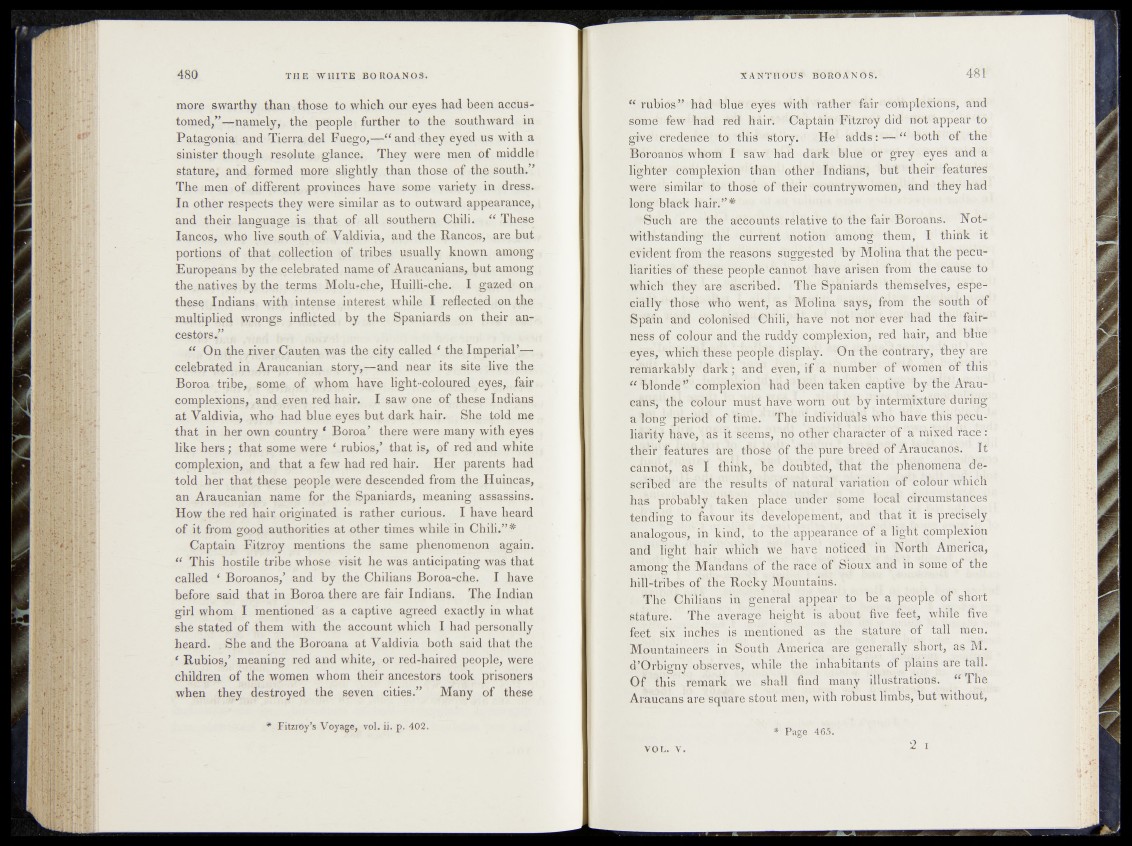
more swarthy than those to which our eyes had been accustomed,”—
namely, the people further to the southward in
Patagonia and Tierra.del Fuego,—“ and -they eyed us with a
sinister though resolute < glance*; They were men of middle!
stature,' and, formed more sightly .than those, of the south.”
The men offlifferprit provinces have some variety in dress.
In other respects they were similar as to outward appearance,
and their, language is . that of all southern Chili- “ These
Iapcos, who live s o u ^ o f Yaldivia, and the Etaneos, are hut
portions of that .collection of tribes usually known among
Europeans by the celebrated name of Araucanians, but among
the natives by the terms Molu-clie, Huilli-che. I gaaed on
these Indians, with intense interest while I reflected, on ,$>#
multiplied wrongs inflicted by the Spaniards on their ancestors/’
,
,“ .On tb e .river Cauten was the city called ‘ the Imperial’^
celebrated in Araucanian story,—and near its site live the
Boroa tribe,, some, of whom have light-coloured eyes?., fair
complexions? and even red hair. I saw one of these Indians
at Valdivia, whp had blue eyes but dark hair. She told me
that in her own country ‘ Boroa’ there were many with eyes
like hers; that some were ‘ rubios,’ that is, of red and white
complexion, and that a few had red hair. Her parents had
told her that these people were descended from the Iluincas,
an Araucanian name for the Spaniards, meaning assassins.
How the red hair originated is rather curious. I have heard
of it from good authorities at other times while in Chili.” #
Captain Fitzroy mentions the same phenomenon again.
H This hostile tribe whose visit he was anticipating was that
called * Boroanos,’ and by the Chilians Boroa-che. I have
before said that in Boroa there are fair Indians. The Indian
girl whom I mentioned' as a captive agreed exactly in what
she stated of them with the account which I had personally
heard. . SJje and the Boroana at Valdivia both said that the
‘ Rubios,’ meaning red and white,. or red-haired people, were
children of the women whom their ancestors took prisoners
when they destroyed the seven cities.” Many of these
* Fitzroy’s Voyage, vol. ii. p. 402.
K With râthëW’ fai r "ebthplexions, and
s©me ? feW-*had red h l i r * t i il 'Fftzréÿ did fieri feppeâr to
t a 'ites^StoW^1 He^ aéd$y^h'd4§ëth of thej
Bëroanb^'whtom I Ww^h^-tl dUk blue or ^grey * %ÿêê httdr;a
lighter complexion* ' thràri * è*r ^ Indians, but ' their'Teatufes
were •sitÉllâ!^1 to 1 ;t h b i i ^ b f 1 they hadJ
longhlabk half I” # 5 H
«MBucli are the^a^dëb%S*reîêftn% tb th e fair Borbanst* Net*4“
W?#fsfcaftdi^g' thé curreht notion ambiig’Hhetft, I think it
efident frofh';tl^ fCaSoftS sb^e-sted fàjHMolina that the^éèn-
liaritiékhf these pëoplfe'ôaiïnot htîve ûrfèèéi ‘from £he*fisÆfëfe‘$b
which they We ‘ Ascribed! The'Spaniards AhëtnsëivbspeêpW1
wh& weiit,1 %»’ froth: thè‘i<Milth br
Spdn^attd ftilohfehd**C h i l i htill tb è ’FaiW
i^ess of colour and the' ruddy complexion, red hair, and Mire*
eyes, which tlfgife plopfe dîèplà'y. On thë’hôntVaVy, thbÿ are
r^ttfàrkâHlÿ^flarfe $ âtrd' if à W1 u n f
“ Monde” cômplèktbn'hud We W tàken captivé by- ther5Ahau-'
cdtts/'thè tspîôu r mflst _ hWe worti 'but by ifttetwhxtû^h' d ufWç
a ïBnc^tWibif' of titnev^ The Individuels whb hâv’e this* pèbu-
liÉ w sffc 'ÏS5 oî^p,hharacferiSF-#fùjxOT
f;hèm f e â t h f t h b s ^ ^ f thë'pure îûeScFof Àr’^^aùos. îtr
c fflô tf ‘^s I thmk, be Mbithfëd, ^hat tîhrphhhomëha jdpf
scriheclWe ‘the rësulèvbf nàtufaT variation bf côïôur which
has’” prèbably^taien piacb under some local’ clfdùmstanees
tending to favouir1tslflèveîopèment', and tKat'% is ;ipr'^fôèTy'
analogous? in kind,’*to the appeàr&Ww a'IIgm complexion
and light hair which we' have, noticed in Norfli* America,
among tjie Mandans .of the ràcç of Sioux and in sonie of the
hill-tribes of the liocky î^çuntains. •
; The Chilians in ^general appear 10 a^gopîe' of' stork
stature. The average Height ' is about five reeiy .while five
feet six inchetf is mentioned as the âjWufë.o f tafl men.
Mountaineers in Ssbuth America 'are generally shorr,* as M^
d’Orbigny observes, while the inhabitants of plains are tall.
Of this .remark wè; shall find many Ilh^tfuhbtis. “
Aiaucans are square stout mèn|^lm rbhusl Itthos, but withbilt,
v o l . v.